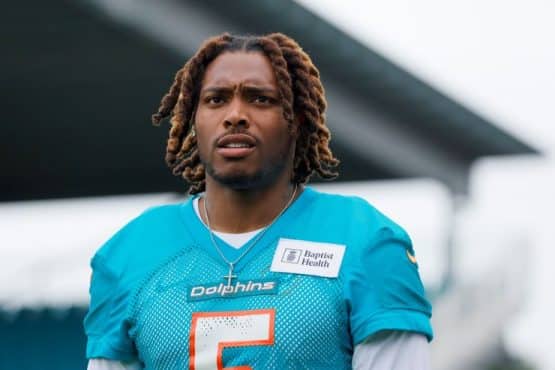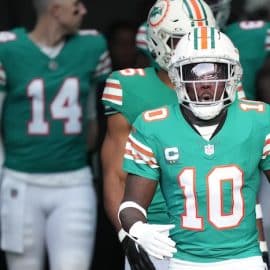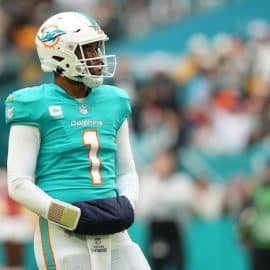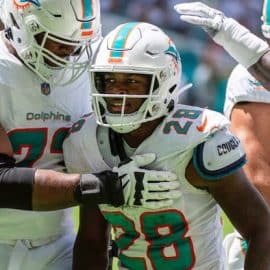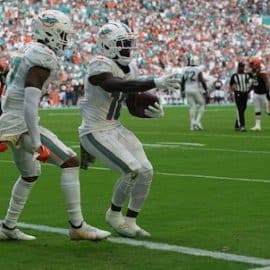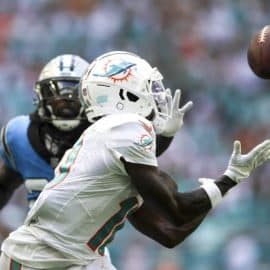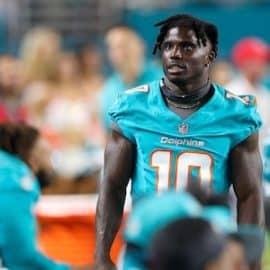As the offseason starts to roll on, many intriguing roster decisions await the hopefully soon-to-be named new GM. Amongst these is what to do in the secondary. Let’s review where the current roster stands today.
Heading into 2014 the Dolphins have the following defensive backs under contract (position, cap number, cap savings if cut) – Dimitri Patterson (CB, $5.4M, 5.4M), Reshad Jones (S, $3.61M, – 9.76M), Jimmy Wilson (S/CB, $1.4M, 1.389M), Jamar Taylor (CB, $824K, -489K), Will Davis (CB, $630K, 239K), Don Jones (S, $507K, 472K), Michael Thomas (S/CB, $495K, 495K), and Jordan Kovacs (S, $495K, 495K). Notable free agents include Brent Grimes (CB), Chris Clemons (S), and Nolan Carroll (CB).
Context – Cap Space, Team Needs, and Performance
As I recently covered with Jason Fitzgerald from www.overthecap.com, the Dolphins are in healthy cap shape heading into this offseason with approximately $33 M in cap space before any cuts or signings are made. Of course one cannot think about which players the team might re-sign or let go in the secondary without admitting the multiple other roster needs that demand attention as well. Notably, the offensive line needs a near-complete rebuild with only Mike Pouncey set to return as a sure-shot starter. Even with a lineman-centric draft, realistically the team will likely be looking to find at least one, if not two, starters for the line through free agency. Beyond the starters in the secondary due to become free agents, Miami also has a potential cap-hit coming at defensive tackle, where starters Randy Starks and Paul Soliai are both set to test the open market. Lastly, while confounded by a mediocre offensive line in 2013, neither Lamar Miller nor Daniel Thomas is necessarily the long-term answer at running back; a position integral to the system that Bill Lazor plans to bring the team. Suffice it to say, the secondary is not the only unit requiring offseason attention.
Now let’s take a look at the 2013 Dolphins secondary performance.
|
Stat |
Passing Yds/g |
Passing TDs |
INTs |
Comp. % |
Yds/A |
Passer Rtg. |
|
Value |
234.5 |
17 |
18 |
59.3 |
6.9 |
77.3 |
|
League rank |
16th |
3rd |
10th |
14th |
12th |
5th |
As a unit, the secondary had a respectable season. The passing yardage allowed in 2013 was around average, but allowing 17 passing TDs combined with 18 INTs contributed towards keeping opposing quarterbacks to the 5th lowest passer rating in the league.
ProFootballFocus (via subscription) supports this performance and ranks the Dolphins as having the 11th best rated defense in pass coverage in 2013. Football Outsiders, using their defensive efficiency ratings – http://www.footballoutsiders.com/stats/teamdef, also found that the Dolphins pass defense performed respectably with a 12th best overall ranking.
Individual Performances
Below I’ve compiled the PFF ratings for the members of the secondary that saw significant playing time in 2013 (not shown are Michal Thomas and RJ Stanford). The table is sorted in order of best to worst PFF overall rating. Rookies Jamar Taylor and Will Davis were included, although they played minimally, as they are notable returning members in 2014. The league rank is relative to that individual’s primary position (CB or S).
|
Player |
Overall Rtg. |
Run Def. |
Pass Rush |
Pass Cov. |
Play Count |
League Rank |
|
Grimes, B. |
16.4 |
-0.5 |
-.0.1 |
12.0 |
1132 |
2nd |
|
Patterson, D. |
5.0 |
-1.0 |
0.8 |
5.1 |
241 |
31st |
|
Clemons, C. |
4.1 |
-3.6 |
-1.5 |
7.2 |
1158 |
19th |
|
Wilson, J. |
1.0 |
-1.7 |
-1.1 |
1.1 |
625 |
49th |
|
Carroll, N. |
0.9 |
0.4 |
0.3 |
-4.4 |
809 |
52nd |
|
Taylor, J. |
-1.3 |
0.1 |
0.1 |
-1.5 |
45 |
– |
|
Davis, W. |
-3.7 |
-0.9 |
0 |
-3.1 |
65 |
– |
|
Jones, R. |
-6.9 |
-0.6 |
-1.6 |
-4.7 |
1167 |
68th |
At cornerback, the clear standout in this list is Brent Grimes. On his way to earning to earning a Pro Bowl nod, Grimes consistently played at an elite level and finished the season ranked as PFF’s 2nd best overall CB. The remaining players had mixed performances. Patterson played only sparingly due to injury, but he earned an above average rating against the pass. Jimmy Wilson, projected in the pre-season to play as a safety, was thrown into play (due to injury) predominantly as a nickel CB, and earned a positive, but only just above average grade. Carroll improved significantly over his 2012 performance (when he ranked 67th overall), but still earned an only slightly above average grade in 2013. Of note, Carroll was the only player in Miami’s secondary with a positive grade against the run. There isn’t much to say about rookies Taylor and Davis other than that they barely played with a measly combined 110 total snaps.
At safety, Chris Clemons had a solid season for the 2nd year in a row ranking as the 19th highest graded safety overall and performing well against the pass. Reshad Jones, fresh off signing a lucrative 4-year extension and rated as the 3rd best safety by PFF in 2012, was a major let-down and rated as a lower-tier safety.
Contractually, as previously noted, free agents include Grimes, Clemons, and Carroll. Patterson, with a potential cap savings of $5.4 M if cut, has frequently been pointed to as a potential cap casualty. Aside from a potential savings of $1.389 M for Wilson, no other member of the secondary would contribute significantly to cap space through a cut.
FA Market
Two useful lists showing us the 2014 free agents by position – via PFF and OTC – can be found here – https://www.profootballfocus.com/blog/2014/01/07/2014-pff-free-agency-tracker/ – and here – http://overthecap.com/freeagents.php?Position=CB&Year=2014 .
CB
The free agency market at CB is not devoid of top talent. Aside from 31 yr old Grimes, standout names include: 25 yo Verner (12th ranked CB by PFF in ’13), 27 yr old Talib, former Dolphin 25 yr old Vontae Davis (3rd), 27 yr old Dominique Rodgers-Cromartie (5th), and 25 yr old Munnerlyn (11th). 32 yr old Charles Tillman, although he had an underwhelming 2013 campaign, is another vet to keep an eye on after being ranked as PFF’s 3rd highest rated CB in 2012.
Time will tell us about the going price generated by this market, but one useful point of reference is 30 yr old Tim Jennings’ recent contract. Jennings, after a solid 2013 in which he replaced Richard Sherman at the Pro Bowl, signed a 4-year deal to remain with the Bears for $22.4 M ($5.6 M/year), including about $11.8 M guaranteed.
S
The free agent safety market appears similar to the CB market. Top-notch starters, with higher ratings than Chris Clemons in 2013, are limited to 27 yr old T.J. Ward, 29 yr old Donte Whitner, and 27 yr old Jairus Byrd. Other potential cheaper veteran options include 30 yr old James Ihidegbo and 29 yr old Bernard Pollard.
Draft Market
The depth of the CB and S positions in the 2014 is important to consider as most draftniks have the Dolphins taking offensive linemen in the early rounds.
Safety talent in this draft appears to be quite thin overall. Mel Kiper Jr.’s most recent big board has Alabama’s Ha Ha Clinton-Dix, a projected FS, at 23rd overall and Louisville’s Calvin Pryor at 25th overall. Outside of these top-tier talents, Scouts Inc. only has Baylor’s Ahmad Dixon ranked in their top 100 players for the 2014 draft. The take-home message here is that finding starter talent at safety appears extremely unlikely in this year’s draft.
CB however is quite a different story; in fact, most draft analysts have been describing CB as one of the deeper positions in the 2014 draft. Kiper has 3 CBs going in the first round of his first mock draft. Scouts Inc. has 11 CBs in their top 100 players and 19 CBs in their top 150.
The GM Caveat
Before trying to put this complex picture together, it is essential to point out the obvious – The Dolphins will have a new GM in 2014. Fans may be tied to certain players, but it is undeniably possible that the new GM will favor new players that fit his vision and mold. A theoretical analysis regarding any of these positions has to take the cliché, but reality-reflecting, phrase into account – “every GM wants his guys.” Counter-balancing this influence towards potential change will be the continuity that Miami has in bringing back the majority of the defensive staff.
The Decision – Balancing cost, value, and alternatives
Now let’s try and put all of this together. To summarize, the Dolphins have some crucial decisions to make at secondary this offseason. Although these include the possibility of cutting oft-injured Dimitri Patterson, I’ve chosen to focus on the questions revolving around free-agents Grimes, Carroll, and Clemons. Although the Dolphins salary cap is in good shape, one should keep in mind the need to rebuild the offensive line and the impending decisions at defensive tackle with Randy Starks and Paul Soliai set to become free agents as well.
Brent Grimes
Brent Grimes, to me, presents arguably the easiest of all decisions. Playing on a 1-year “show me” contract, Grimes dominated the competition and displayed rare and elite playmaking ability. Players like Brent Grimes are not easy to find and, accordingly, he will be amongst the top-targeted free agents this year. With the substantial “can’t really trust PR” grain of salt taken, he also seems genuinely happy to be a Miami Dolphin and that he’d like to work out a long-term deal to stay. In looking at alternatives, there are few, if any, through free agency that would not be at least a substantial downgrade. Internally the Dolphins have no candidate that stands out as a clear-cut number one shutdown corner in Patterson (oft-injured, potentially cut), Wilson (converted safety filling a hole), Carroll (serviceable #2 or 3, potentially gone via FA), or in the two near-completely unknowns Taylor and Davis (barely played as rookies).
The only thing standing in the way of making Grimes a no-brainer re-signing? That dirty little thing called money. Make no mistake, although he is 31, which could help temper an outrageous price, Grimes will be a highly sought-after free agent. If he commands too high a premium, with so many other needs, it would present the team with a difficult conundrum. In his recent interview with us, Jason Fitzgerald suggested a not-cheap, but affordable, $7.5 M/year deal with $13-15 M guaranteed. The other, less-optimal possibility, in the event that a long-term deal can’t be reached, is to place the franchise tag on Grimes (a move projected to top $11 M/year by most estimates).
In short, due to his talent, and the lack of readily available alternatives through FA or the draft, I believe it would be best to re-sign Brent Grimes to a long-term deal or, worst-case scenario, slap the franchise tag on him.
Nolan Carroll
Nolan Carroll presents a more difficult cost/benefit analysis. While his performance notably improved in 2013, he is not an irreplaceable player. Complicating the equation is a free agent market that certainly has comparable performers, a truly deep CB draft class, and two potential replacement in-house options with Jamar Taylor and Will Davis. If Grimes is lost to a competitor, it certainly alters the picture, but my sense is that it would be best to investigate the available free-agents and demand a very appropriate contract if Carroll is to be kept. Carroll is familiar with the Dolphins defensive schemes, but CB is typically not amongst the more complicated positions to bring immediate ‘plug-and-play’ veterans into; in so many words, he shouldn’t have too much leverage. In sum, the decision on whether to bring Carroll back largely depends on his price – if he asks for too much, I don’t think the new GM should hesitate to let him walk.
Chris Clemons
Although Reshad Jones received the big recent contract at safety, Chris Clemons was the better performer in 2013. Clemons strong play holds true even when placed in a league-wide context with a 19th overall positional ranking by PFF. Putting his performance aside, the key to the decision on whether or not to re-sign Clemons lies in the alternatives. Internally, the team has virtually nobody that is ready to immediately start opposite of Reshad Jones. The draft offers no relief with only 2 possibly (and no sure thing) elite players; moreover, each is likely to go while the team fills its needs at offensive line. The free agency pool at safety, though offering some viable options, suggests only a few players that would be an upgrade to Clemons. In sum, with the ever-present price disclaimer stated (he shouldn’t command a fortune), Clemons seems to be an attractive candidate to keep in-house.
An Ode to Complexity
As fans, we often simplify the complexity of personnel decisions that teams constantly face. Why do we do this? Well, it’s fun, easy, and the fantasy-football approach seems to offer near-instant fixes for major roster issues. The rough truth of roster management is that it’s actually tremendously complicated. In order to make the most intelligent decision on any given player, a GM must take into account an enormous number of variables. These include an analysis of a given player’s past performance, a projection of future performance, input from coaches on in-house alternatives, input from scouts on draft options, and a close eye on the free agent market. Meanwhile, other positional priorities demand continuous consideration in order to build the most complete roster and any payment for performance requires thorough consideration of the counterbalancing cost. In no way am I suggesting that my short analysis approaches anything close to what NFL personnel departments prepare, but I do hope that I’ve at least hinted at the nuanced complexity that is roster management.
Pablo Knowles can be found on twitter @pabloknows or via email at – pabloknows54@gmail.com
Add The Sports Daily to your Google News Feed!

